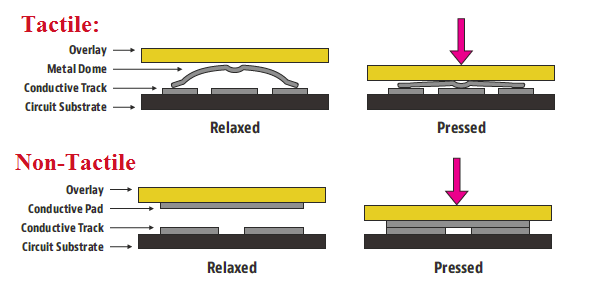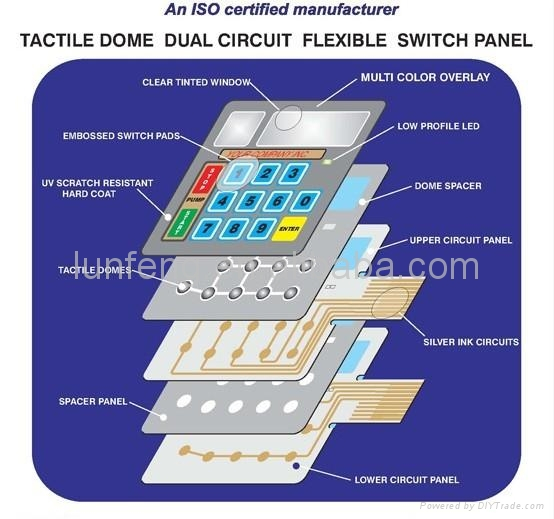Comprehending the Value of Membrane Switches in Interface
Membrane switches are essential components in the style of efficient interface, promoting not only functionality yet also boosting aesthetic allure and individual interaction. Their distinct functions, such as resistance to personalized styles and environmental factors, make them suitable for a varied selection of applications across multiple industries. As we check out the different advantages and future trends connected with Membrane modern technology, it becomes clear that these switches are a lot more than just parts; they stand for a merging of development and usefulness. The effects of this innovation on user experience are worth analyzing further.
What Are Membrane Buttons?

The spacer layer, which includes glue residential or commercial properties, enables for the separation of the circuit layer from the overlay, ensuring that the button continues to be in a non-activated state till pressed. When stress is put on the overlay, it presses the spacer layer, bridging the space and finishing the circuit in the underlying layer. This style not just lowers the physical room needed for typical mechanical buttons yet likewise enhances the resilience of the tool, as Membrane switches are generally immune to dust, dampness, and various other ecological aspects.
Commonly discovered in applications varying from consumer electronic devices to clinical tools, Membrane buttons are important to modern innovation, giving a user-friendly and reliable user interface that aligns with contemporary design needs.
Advantages of Membrane Switches
While countless switch innovations exist, Membrane Switches offer distinctive benefits that make them particularly desirable in various applications. Among the key advantages of Membrane switches is their portable design, which permits space-saving implementations in tools where property is limited. Their slim profile not just improves visual allure yet also facilitates light-weight construction.
One more considerable benefit is their resistance to ecological aspects. Membrane switches are typically secured against moisture, dirt, and pollutants, making them perfect for use in requiring atmospheres, such as clinical gadgets and commercial tools. This resilience expands the life-span of the button, reducing upkeep prices and enhancing dependability.
In addition, Membrane switches can be tailored to satisfy particular design demands, including distinct graphics and colors that enhance individual interaction. Their responsive comments choices can likewise be customized to provide a gratifying user experience. Additionally, Membrane buttons are cost-effective, especially in high-volume applications, as they can be produced successfully.
Applications in Various Industries

In the customer electronics market, Membrane buttons prevail in devices such as microwaves, washing devices, and remotes. redirected here Their tactile feedback and visual alternatives boost user experience while giving a smooth, contemporary appearance. Furthermore, automotive producers make use of Membrane buttons in dashboard controls and infomercial systems, where space is restricted, and customer interaction is critical.
Additionally, the commercial sector leverages Membrane switches in control panels for machinery and devices, permitting user-friendly procedure in frequently harsh settings. Their resistance to chemicals and dampness guarantees longevity and reliability in these applications. In general, the adaptability of Membrane Switches contributes considerably to their prevalent use, making them indispensable in various technological domains.
Design Factors To Consider for Membrane Switches

When designing Membrane switches, several vital considerations should be considered to make certain optimum capability and customer experience. To start with, the selection of materials is crucial; choosing resilient, high-grade substrates can enhance the button's longevity and resistance to ecological elements such as moisture and temperature level fluctuations.
Secondly, the style of the graphic overlay should prioritize clearness and convenience of use. Icons and text must be clear, and the format needs to facilitate intuitive interaction (membrane switches). Additionally, tactile comments is necessary; including a responsive dome or other mechanisms can enhance the user experience by supplying physical verification of activation
An additional vital aspect is the switch's electrical performance. Designers must make certain that the conductive traces are correctly designed to reduce resistance and prevent signal interference. This involves examining the needed actuation pressure and ensuring compatibility with the electronic elements they will interface with.

Future Patterns in Membrane Modern Technology
As innovation remains to breakthrough, Membrane switches are poised to progress dramatically, driven by technologies in materials and making strategies. One emerging trend is the incorporation of innovative materials, such as conductive inks and adaptable substratums, which improve longevity and minimize the general weight of Membrane linked here switches. These materials not only improve the tactile reaction but likewise enable for the design of buttons that can hold up against harsher environmental problems.
Additionally, the combination of touch-sensitive innovations is changing traditional Membrane Switches right into even more interactive interface. Capacitive touch sensing units embedded within Membrane button panels can offer a much more instinctive and responsive customer experience, straightening with the growing need for sleek, modern designs in consumer electronic devices.
Additionally, improvements in printing strategies, such as digital and 3D printing, allow fast prototyping and customization of Membrane buttons. This versatility enables producers to respond faster to market demands and consumer choices.
Finally, sustainability is coming to be a considerable emphasis, with makers checking out green materials and processes. As these patterns unravel, the future of Membrane modern technology assures boosted performance, aesthetic allure, and environmental obligation, solidifying their function in sophisticated user interfaces across various sectors.
Conclusion
To conclude, Membrane Switches stand for a vital component in the design of interface, incorporating functionality with aesthetic adaptability. Their advantages, consisting of toughness and resistance to ecological variables, make them suitable for diverse applications across different sectors. Moreover, thoughtful design factors to consider boost individual interaction and experience. As developments in modern technology continue, the development of Membrane switches is anticipated to additional improve interface, driving development you can check here and boosting use in a significantly complex technical landscape.
Membrane switches are indispensable elements in the design of efficient user interfaces, assisting in not only capability however additionally improving aesthetic appeal and customer communication.Membrane Switches offer as an essential component in different user interfaces, facilitating a seamless interaction between customers and electronic gadgets.While countless button innovations exist, Membrane Switches deal distinct advantages that make them particularly preferable in different applications.Furthermore, Membrane switches can be personalized to satisfy specific style requirements, including one-of-a-kind graphics and shades that boost individual interaction.In verdict, Membrane Switches represent an important element in the design of individual interfaces, combining functionality with aesthetic flexibility.